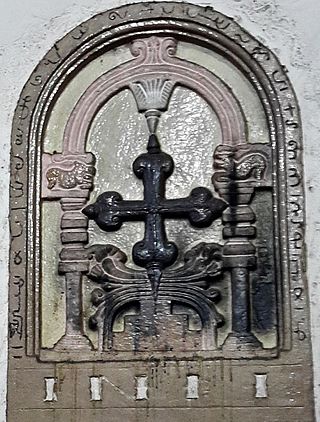
The Saint Thomas Christians, also called Syrian Christians of India, Marthoma Suriyani Nasrani, Malankara Nasrani, or Nasrani Mappila, are an ethno-religious community of Indian Christians in the state of Kerala, who, for the most part, employ the Eastern and Western liturgical rites of Syriac Christianity. They trace their origins to the evangelistic activity of Thomas the Apostle in the 1st century. The Saint Thomas Christians had been historically a part of the hierarchy of the Church of the East but are now divided into several different Eastern Catholic, Oriental Orthodox, Protestant, and independent bodies, each with their own liturgies and traditions. They are Keralites and speak Malayalam. Nasrani or Nazarene is a Syriac term for Christians, who were among the first converts to Christianity in the Near East.

The Syro-Malabar Church, also known as the Syro-Malabar Catholic Church, is an Eastern Catholic Church based in Kerala, India. It is a sui iuris (autonomous) particular Church in full communion with the Pope and the worldwide Catholic Church, including the Latin Church and the 22 other Eastern Catholic Churches, with self-governance under the Code of Canons of the Eastern Churches (CCEO). The Church is headed by the Major Archbishop of the Syro-Malabar, Raphael Thattil. The Syro-Malabar Synod of Bishops canonically convoked and presided over by the Major Archbishop constitutes the supreme authority of the Church. The Major Archiepiscopal Curia of the Church is based in Kakkanad, Kochi. Syro-Malabar is a prefix reflecting the church's use of the East Syriac Rite liturgy and origins in Malabar. The name has been in usage in official Vatican documents since the nineteenth century.
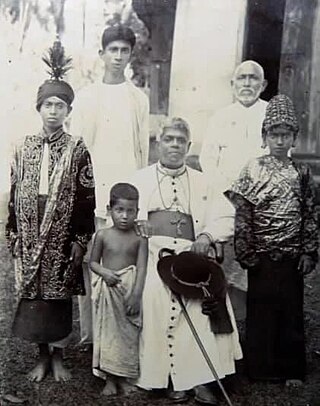
The K'nānāya, also known as the Southists or Tekkumbhagar, are an endogamous ethnic group found among the Saint Thomas Christian community of Kerala, India. They are differentiated from another part of the community, known in this context as the Northists (Vaddakkumbhagar). There are about 300,000 Knanaya in India and elsewhere.

The Synod of Diamper (Udayamperoor Synod) (Malayalam: ഉദയംപേരൂർ സൂനഹദോസ്, romanized: Udayampērūṟ Sūnahadōs), held at Udayamperoor (known as Diamper in non-vernacular sources) in June 1599, was a diocesan synod, or council, that created rules and regulations for the ancient Saint Thomas Christians (also known as Mar Thoma Nasranis) of the Malabar Coast, a part of modern-day Kerala state, India, formally subjugating them and downgrading their whole Metropolitanate of India as the Diocese of Angamale, a suffragan see to the Archdiocese of Goa administered by Latin Church Padroado missionaries. This synod also introduced forced Liturgical Latinisation and the eschewal of local practices and beliefs, leading to a significant ecclesial protest by Saint Thomas Christians known as Coonan Cross Oath and a subsequent schism in the mid-17th century.

The Coonan Cross Oath, also known as the Great Oath of Bent Cross, the Leaning Cross Oath or the Oath of the Slanting Cross, taken on 3 January 1653 in Mattancherry, was a public avowal by members of the Saint Thomas Christians of the Malabar region in India, that they would not submit to the Jesuits and Latin Catholic hierarchy, nor accept Portuguese dominance in ecclesiastical and secular life.

Margamkali is an ancient Indian round dance of the St. Thomas Christians community- based in Kerala state, mainly practiced by the endogamous sub-sect known as the Knanaya or Southist Christians. The dance retells the life and missionary work of Thomas the Apostle, based on the 3rd-century apocryphal Acts of Thomas.
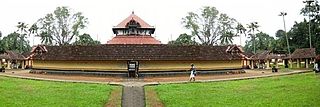
Kaduthuruthy is a town in Kottayam District in the state of Kerala, India.
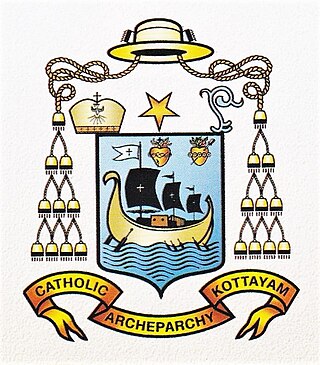
The Syro-Malabar Catholic Archeparchy of Kottayam is a metropolitan Archeparchy of the Syro-Malabar Catholic Church in India. The Archeparchy is exclusively for Knanaya faithful who are the descendants of Syriac Judeo-Christians who migrated from South Mesopotamia to Kodungallur (Muziris) in South India in 4th century.
Mar Thoma I, also known as Valiya Mar Thoma and Arkkadiyakkon Thoma in Malayalam and Thomas de Campo in Portuguese was the first native-born, popularly-selected Metropolitan bishop of the 17th-century Malankara Church. He was the last Archdeacon of the undivided St. Thomas Christians of Malankara (Maliyankara).

This article lists the various old and ancient churches that exist among the Saint Thomas Christians in Kerala.

Thomas of Cana was a Syrian Christian merchant magnate who arrived to the Chera Dynasties capital city of Kodungallur between 345 C.E. and 811 C.E. Thoma brought with him Jewish-Christian families and clergymen from Persian Mesopotamia.

Mor Gregorios Abdal Jaleel Bawa was the Syriac Orthodox Bishop of Jerusalem from 1664 until his death in 1681. He is chiefly remembered for his 1665 mission to India, by which he established ties between the Malankara Church and the Syriac Orthodox church of Antioch. He is venerated as a saint by his church.

The Malankara Church, also known as Puthenkur, is the historic unified body of West Syriac Saint Thomas Christian denominations which claim ultimate origins from the missions of Thomas the Apostle. This community, under the leadership of Thoma I, opposed the Padroado Jesuits as well as the Propaganda Carmelites of the Latin Church, following the historical Coonan Cross Oath of 1653. The Malankara Church's divisions and branchings have resulted in present-day Churches that include the Jacobite Syrian Christian Church, the Malankara Orthodox Syrian Church, the Malankara Mar Thoma Syrian Church, the Malabar Independent Syrian Church, the Syro-Malankara Catholic Church, the Saint Thomas Anglicans of the Church of South India and the St. Thomas Evangelical Church of India.

Kariattil Mar Iousep, alternatively written as Mar Joseph Kariattil, was the first native Indian to be appointed as Metropolitan of Kodungalloor (Cranganore) for Syrian Catholics in the territory now comprising Kerala, India.
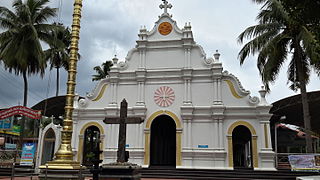
The Mulanthuruthy Marthoman Orthodox Syrian Cathedral is an ancient church located at Mulanthuruthy in Ernakulam district in Kerala, India. This church was founded and established in the 11th century A.D,the church was consecrated on 3rd Karkkidakkam (July), in between 1100 and 1125 A.D. The church was modified in the 16th century A.D. The carvings on the main door of the church, made of granite, on which is inscribed in Syrian script, read as ʹʹthe door of the Mar Thoman Church was re-erected on 9th Thulam 1575 A.D.ʹʹ It is one of the ancient Churches in Kerala.

Palliveettil Chandy also known as Parambil Chandy was a bishop of the Catholic Saint Thomas Christians. He is also the first known native Indian bishop.

The Saint Thomas Christian denominations are Christian denominations from Kerala, India, which traditionally trace their ultimate origins to the evangelistic activity of Thomas the Apostle in the 1st century. They are also known as "Nasranis" as well. The Syriac term "Nasrani" is still used by St. Thomas Christians in Kerala. It is part of the Eastern Christianity institution.

Kaduthuruthy Marth Mariam Knanaya Major Archiepiscopal Church, commonly called Kaduthuruthy Valiapally or the Great Church of Kaduthuruthy, is a historic church founded by the Knanaya community in 400 C.E. The Knanaya are the descendants of Syriac Judeo-Christians who migrated from Persian Mesopotamia to Kodungallur, Kerala, during the medieval era.

Kadavil Chandy Kathanar, also known as Alexander the Indian was a Kathanar (priest) and a celebrated scholar, orator, hymnographer and syriacist from the Saint Thomas Christian community in India. He was a prominent face of the Saint Thomas Christians and lead their Catholic faction during a turbulent period of divisions in the community after the Coonan Cross Oath of 1653. He was from Kaduthuruthy, Kottayam in Kerala state of India. He often reacted vehemently against the colonial Padroado latin subjugation over his community and resisted their ecclesiastical and cultural dominance. He was widely reputed for his knowledge in Syriac language and literature, and was often praised, both among his own community and the European missionaries who wrote about him in their letters addressed to the Portuguese monarch and to the Pope. His acrostic poems propagated even among West Asia's Syriac-speaking communities. Although he stood against the Latin colonialists, he commanded respect from the Portuguese and the local Hindu kings alike.

The Paḻayakūṟ, also known as Romo-Syrians or Syrian Catholics of Malabar, are the East Syriac denominations of the Saint Thomas Christian Church, which claim ultimate apostolic origin from the Indian mission of Thomas the Apostle in the 1st century AD.














